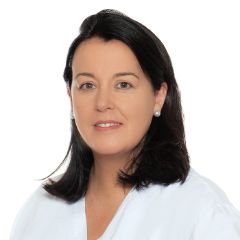
SteamOne
Study information page of SteamOne - Prospective registry database for recum vapor therapy of the prostate
This platform provides information for patients treated with Rezum steam therapy in a participating study center as part of SteamOne as well as for healthcare professionals from participating study centers.
Director of Studies

Director of Studies

Director of Studies

Study coordinator


Contact us
Phone +41 61 328 56 59
E-mail: SteamOne.Urologie@usb.ch
Prospective registry database for recum water vapor therapy of the prostate - Brief information for patients
Aim of the study
Benign prostate enlargement is one of the most common diseases in ageing men. However, the glandular tissue of the prostate in the transition zone can begin to grow from the age of 30. Statistically speaking, half of all men between the ages of 50 and 60 already have benign prostatic hyperplasia (BPH) (1). The excess tissue can lead to a narrowing of the prostatic urethra, which is referred to as benign prostatic obstruction (BPO), which can lead to an increase in bladder outlet resistance. BPO can lead to stressful symptoms of the lower urinary tract, so-called "lower urinary tract symptoms" (LUTS).
The incidence of LUTS due to BPO is 3/100,000 men per year in the 45-49 age group and rises to a maximum of 38/100,000 men per year in the 75-79 age group. For a symptom-free man aged 46, the risk of developing BPO-related LUTS in the next 30 years is therefore 45% (2).
There is a demonstrable need for patient-centered treatment decisions that focus on the patient's needs. Accordingly, a large number of minimally invasive treatment techniques have been developed in recent years (3).
Rezum water vapor therapy of the prostate is understandably arousing the interest of treating physicians and men suffering from BPO-induced LUTS, as Rezum has been shown to be able to significantly improve urination (4,5) as well as protect sexual function (6,7). In addition, Rezum can be performed under local anesthesia and without general or spinal anesthesia, which means that older or multimorbid patients can also be treated with Rezum. However, further studies, such as SteamOne, are needed to validate the promising data from the aforementioned pivotal studies, which will hopefully lead to evidence- and guideline-based recommendations for Rezum in the future in order to better advise and treat patients.
The aim of the SteamOne study is to further improve the data available on Rezum treatment. Around 1000 patients will be observed and data collected over a period of 5 years as part of routine treatment with Rezum.
Participation requirements
Inclusion criteria:
- Basically all patients who are treated for BPO/LUTS in the participating study centers
- Age ≥ 18
- The indication for Rezum must be made independently of the study
- The decision to perform Rezum is the responsibility of the patient and the treating medical staff
- Operated or supervised by a certified urologist/urologist
- Subgroups of particular interest are e.g. catheter-dependent patients, patients on oral anticoagulation, patients with preoperative urodynamic pressure-flow examination (not older than 6 months) or patients with a prostate of more than 80 ml
Exclusion criteria:
- Lack of informed consent
- Inability to answer questionnaires independently in German (e.g. dementia, mental disability)
- The patient does not have a personal e-mail address and cannot complete the survey using a relative's e-mail address and is not willing to complete the survey on the tablet in the clinic
- Known or suspected neurogenic bladder dysfunction (e.g. Parkinson's disease, multiple sclerosis or other neurogenic diseases with possible bladder dysfunction)
- History of bladder tumor in the last two years (incl. CIS) or bladder tumor at the time of recurrence treatment (incl. CIS)
- Previous prostate procedures, except prostate biopsies, if these were performed more than 4 weeks prior to the recurrence procedure
- Previous bladder neck surgery
- Bladder neck stenosis requiring treatment at the time of recum treatment
- Planned combination of a simultaneous Rezum treatment with another urological* or medical procedure
* Combination with a planned transurethral procedure is also an exclusion criterion, except in the case of bladder stone removal
Expenditure
As a study patient, you will be asked to answer various questionnaires at certain survey times. These will be sent to you by email link via the study database and can be completed conveniently at home. Study patients will also receive a urine flow meter for use at home free of charge. The data collected in this way is automatically transferred to the study database of the University Hospital Basel via app and smartphone. The time required and the survey and measurement times can be found in the table below.
Risks
No health risks are to be expected.
Risks
No health risks are to be expected.
Benefit
- All data will be treated confidentially.
- Participation in the study is free of charge for patients.
- Study patients receive their own urine flow meter to use at home.
- Some of the questionnaires will also be used for follow-up visits. These can be completed easily and efficiently at home, which means less time in the clinic for study patients.
- Urinary stream measurements do not have to be carried out "on command" in the clinic, but at home at the appropriate time, which should increase the measurement quality.
- The data is automatically and easily transmitted to the study database via an app or email link.
- Last but not least, your own state of health is documented, which is valuable both for you and for the clinic treating you.
Benefit
- All data will be treated confidentially.
- Participation in the study is free of charge for patients.
- Study patients receive their own urine flow meter to use at home.
- Some of the questionnaires will also be used for follow-up visits. These can be completed easily and efficiently at home, which means less time in the clinic for study patients.
- Urinary stream measurements do not have to be carried out "on command" in the clinic, but at home at the appropriate time, which should increase the measurement quality.
- The data is automatically and easily transmitted to the study database via an app or email link.
- Last but not least, your own state of health is documented, which is valuable both for you and for the clinic treating you.
Participating study centers
DISSECTION 2.0 ist eine multizentrische, nationale Studie. Das Universitätsspital Basel ist das koordinierende Zentrum.
Folgende Zentren in der Schweitz nehmen bereits an der Studie teil. Weitere Zentren folgen.
- Universitätsspital Basel
- Kantonsspital Baselland
- Universitätsspital Zürich
